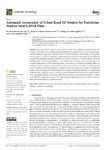Mostrar o rexistro simple do ítem
Automatic Generation of Urban Road 3D Models for Pedestrian Studies From LiDAR Data
| dc.contributor.author | Fernández-Arango, David | |
| dc.contributor.author | Varela-García, Francisco-Alberto | |
| dc.contributor.author | González-Aguilera, Diego | |
| dc.contributor.author | Lagüela, Susana | |
| dc.date.accessioned | 2022-03-28T15:38:41Z | |
| dc.date.available | 2022-03-28T15:38:41Z | |
| dc.date.issued | 2022 | |
| dc.identifier.citation | Fernández-Arango, D.; Varela-García, F.-A.; González-Aguilera, D.; Lagüela-López, S. Automatic Generation of Urban Road 3D Models for Pedestrian Studies from LiDAR Data. Remote Sens. 2022, 14, 1102. https://doi.org/10.3390/rs14051102 | es_ES |
| dc.identifier.uri | http://hdl.handle.net/2183/30295 | |
| dc.description.abstract | [Abstract] The point clouds acquired with a mobile LiDAR scanner (MLS) have high density and accuracy, which allows one to identify different elements of the road in them, as can be found in many scientific references, especially in the last decade. This study presents a methodology to characterize the urban space available for walking, by segmenting point clouds from data acquired with MLS and automatically generating impedance surfaces to be used in pedestrian accessibility studies. Common problems in the automatic segmentation of the LiDAR point cloud were corrected, achieving a very accurate segmentation of the points belonging to the ground. In addition, problems caused by occlusions caused mainly by parked vehicles and that prevent the availability of LiDAR points in spaces normally intended for pedestrian circulation, such as sidewalks, were solved in the proposed methodology. The innovation of this method lies, therefore, in the high definition of the generated 3D model of the pedestrian space to model pedestrian mobility, which allowed us to apply it in the search for shorter and safer pedestrian paths between the homes and schools of students in urban areas within the Big-Geomove project. Both the developed algorithms and the LiDAR data used are freely licensed for their use in further research. | es_ES |
| dc.description.sponsorship | This research study was funded by the Directorate-General for Traffic of Spain, grant number SPIP2017-02340 | es_ES |
| dc.language.iso | eng | es_ES |
| dc.publisher | MDPI | es_ES |
| dc.relation | info:eu-repo/grantAgreement/DGT/Plan Estatal de Investigación Científica y Técnica y de Innovación 2017-2020/SPIP2017-02340/ES/Análisis de indicadores big geo-data sobre viarios urbanos para el diseño dinámico de caminos escolares seguros/ | |
| dc.relation.uri | https://doi.org/10.3390/rs14051102 | es_ES |
| dc.rights | Atribución 4.0 Internacional | es_ES |
| dc.rights.uri | http://creativecommons.org/licenses/by/4.0/ | * |
| dc.subject | LiDAR point cloud | es_ES |
| dc.subject | Mobile LiDAR system | es_ES |
| dc.subject | Point cloud segmentation | es_ES |
| dc.subject | Urban road | es_ES |
| dc.subject | Urban mobility | es_ES |
| dc.subject | Pedestrian accessibility | es_ES |
| dc.title | Automatic Generation of Urban Road 3D Models for Pedestrian Studies From LiDAR Data | es_ES |
| dc.type | info:eu-repo/semantics/article | es_ES |
| dc.rights.access | info:eu-repo/semantics/openAccess | es_ES |
| UDC.journalTitle | Remote Sensing | es_ES |
| UDC.volume | 14 | es_ES |
| UDC.issue | 5 | es_ES |
| UDC.startPage | 1102 | es_ES |
| dc.identifier.doi | 10.3390/rs14051102 |






